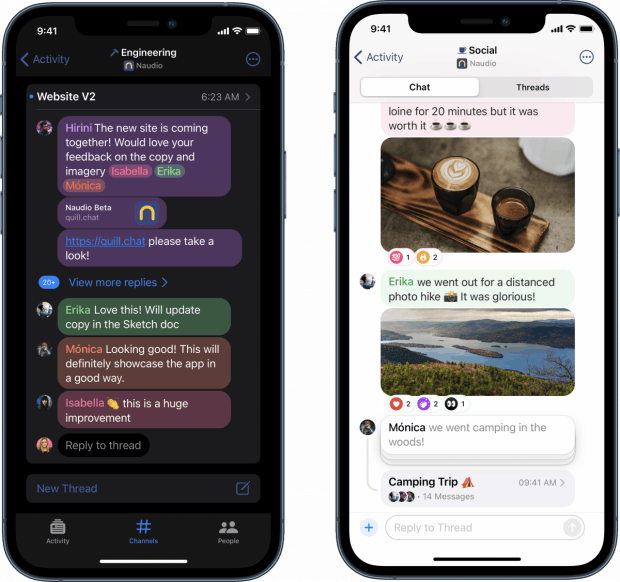New Slack alternative focuses on fewer distractions
No time right now?
Slack and Microsoft Teams get a competitor who approaches the task of team chat a little differently. With better structures and overviews, Quill wants to spend less attention.
The team messenger officially launched on Tuesday Quill wants to be the chat and collaboration solution for people who have to concentrate at work. With this somewhat provocative objective, the new tool aims to position itself against a competition that, from the Quill developers’ point of view, is too prominent.
This is quill. (Screenshot: Quill / t3n)
Contents
Different philosophy: Quill wants to withdraw
According to the Quill philosophy, a team chat has to show its usefulness in the background in order to merely support its users without becoming a protagonist themselves. This is why the new messenger essentially follows a slightly different approach, while optically it is very clearly oriented towards the competition, especially Slack.
The core of the otherness quills is the concept of “structured channels”. These channels are designed in such a way that each entry becomes a separate thread by default. In this way, users in the channel can quickly see which topics are currently being discussed and, if interested, dive into the corresponding thread. In principle, this also works with Slack, but it requires dedicated action on the part of the respondent to a topic. If the respondent does not open a thread, the answer is simply placed under the question. This quickly makes a channel confusing.
Particularly interesting: With Quill, threads can be created very easily retrospectively from any number of messages that have already been posted. You can also make several threads out of one thread if that makes sense, or you can move messages to a thread that is better thematically.

The structured channel on the left, the social channel on the right. (Screenshot: Quill / t3n)
The slack form of the channel is also available at Quill. But here it is called “Social Channel” and is specifically designed as a waterfall timeline. In the “social channels”, users should be able to exchange information informally and without structural requirements – the typical hallway radio.
In addition to the “structured channels”, there is a so-called activity feed, which lists all current developments across all channels and thus offers a kind of meta-overview. The notifications that Quill sends can also be configured in a more granular manner than is the case with Slack. For example, you can specify that only messages that are time-critical or marked as priority are displayed.
To this end, Quill is introducing a new mention format. The @ -mention as with Slack is also available with Quill, but it is passive and does not lead to a notification of the mentioned user. If a user is to be informed, the !! – Mention must be used, which always triggers a push notification.
Interesting video chat feature, voice channels in progress
Quill also offers video chats with screencasts and is working on a clubhouse-like form of operating voice channels. End-to-end encryption will also be available shortly. We are also working on a context search function to supplement the existing keyword search.

Video and text chat combined. (Screenshot: Quill / t3n)
The video chat is designed in such a way that it works side by side with a text chat, via which files or links can also be easily exchanged during the conversation. Quill also offers the option of integrating other services, including Dropbox, GitHub or the Google Calendar.
Prices and availability
Like Slack, Quill can be used for free by small teams. Then Quill is limited to 10,000 messages and five service integrations as well as five gigabytes of storage space per user. There is no limit to the number of messages and integrations on the $ 15 per month Pro plan. Ten gigabytes of memory are also available. Quill is still working on an offer for larger companies.
Like its competitors, Quill also offers native apps for MacOS, Windows and Linux as well as the mobile operating systems iOS and Android. Quill can also be used via a browser. In addition to Quill, Rocketchat is also trying to secure a piece of the team chat pie.
Who is behind Quill
Quill is not a snap shot. The developers have been working on the tool for three years. Quill was founded by Ludwig Pettersson, the former creative director of the payment service Stripe. Pettersson is considered to be the inventor of the simple user interface, which to a large extent contributed to the success of Stripes. Equipped with these merits, Pettersson was able to build on some advance laurels for his new project.
Quill has so far acquired around 14.5 million dollars through various financing rounds and is estimated to have a market value in the upper double-digit million range.



